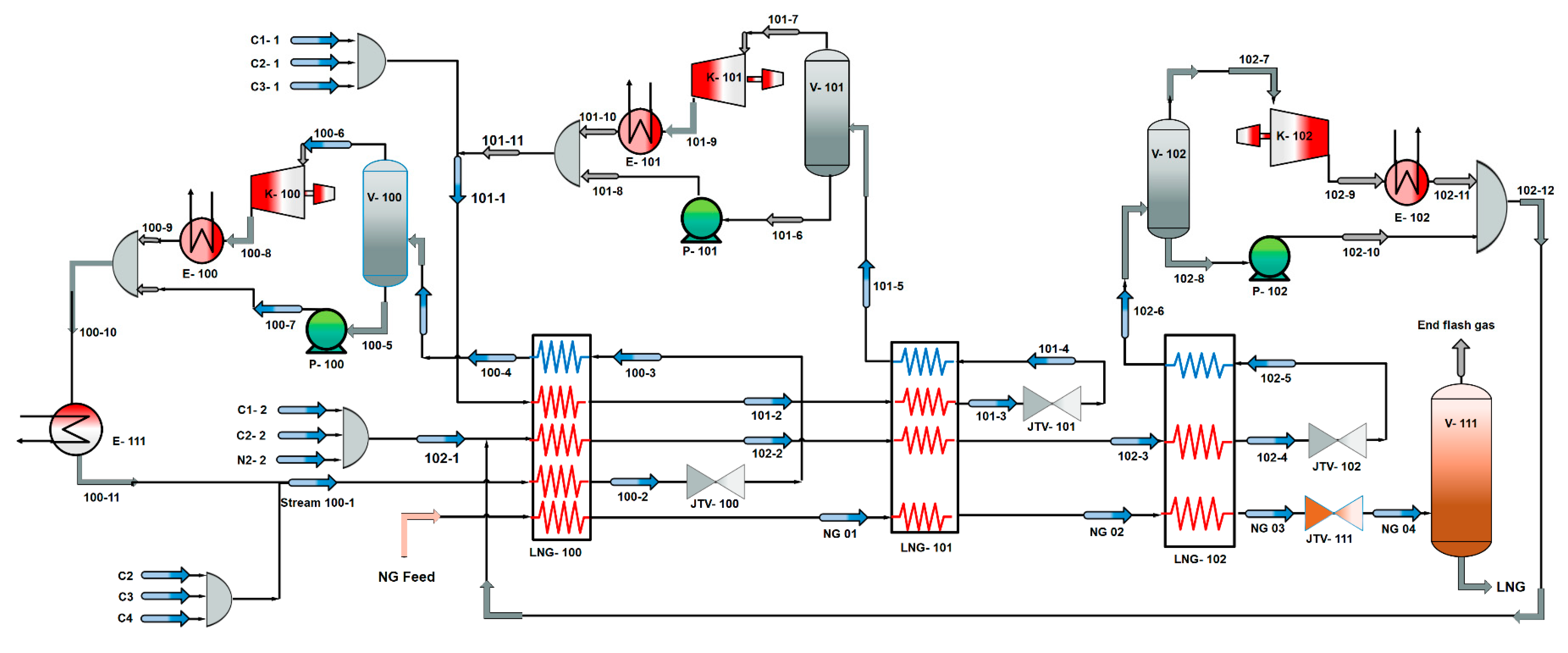Shuffled Complex Evolution-Based Performance Enhancement and Analysis of Cascade Liquefaction Process for Large-Scale LNG Production
Abstract
1. Introduction
2. Methodology: Shuffled Complex Evolution Approach
- (i)
- B and L are sorted such that q points are arranged in ascending order with respect to their respective function values and centroid g is thereafter computed using the expression given in Equation (2):
- (ii)
- The New point is computed in the so-called reflection step.
- (iii)
- A mutation is performed in this step such that if r lies within Ω, energy consumption by the MFC process is computed and Step (iv) is performed; else, the smallest hypercube containing is calculated and fz is computed by randomly generating a point z within H. Finally, we set and .
- (iv)
- A contraction process is performed in this step such that if , is replaced by r and Step () is performed; else is computed followed by fc.
- (v)
- If , is replaced by c and Step () is performed; else, fz is computed by randomly generating a point Z within H. Finally, is replaced by z.
- (vi)
- Step () through () are repeated α times, where α is a user-defined parameter that has a value of ≥1.0.
3. Process Simulation and Description
- (i)
- Peng–Robinson with EOS enthalpy/entropy calculation option was selected for thermodynamic properties calculations.
- (ii)
- The adiabatic efficiency for each compressor was fixed at 80%.
- (iii)
- The minimum temperature approach and pressure drop in LNG exchangers was kept constant at 3 °C and 1 bar, respectively.
- (iv)
- Interstage cooling medium was water, and the water-cooler outlet temperature was 40 °C.
- (v)
- The pressure drop of the water coolers was 0.30 bar.
- (vi)
- Furthermore, it was also assumed that the NG feed composition and conditions remain constant.
4. Simulation–Optimization Environment
5. Results and Discussion
5.1. Pre-Cooling Cycle Composite Curves
5.2. Liquefaction Cycle Composite Curves
5.3. Sub-Cooling Cycle Composite Curves
6. Thermodynamic Performance: Exergy Analysis and Figure of Merit
7. Conclusions
Author Contributions
Funding
Conflicts of Interest
Nomenclature
| Objective function | |
| Exin | Exergy in |
| Exout | Exergy out |
| NG | Natural gas |
| T | Temperature (°C) |
| P | Pressure (bar) |
| MR | Mixed refrigerant |
| MFC_SCE-X | SCE-optimized MFC process corresponding to X iterations |
| Subscripts | |
| SCE | Shuffled complex evolution |
| CCE | Competitive complex evolution |
| I | ith compressor |
| −ve | Negative |
| +ve | Positive |
| Abbreviations | |
| N2 | Nitrogen |
| C1 | Methane |
| C2 | Ethane |
| C3 | Propane |
| nC4 | n-butane |
| M | Mass flow rate (kg/h) |
| TCF | Trillion cubic feet |
| MFC | Mixed fluid cascade |
| LNG | Liquefied natural gas |
| TDCC | Temperature difference composite curves |
| THCC | Temperature-heat flow composite curves |
| DMR | Dual mixed refrigerant |
| JTV | Joule–Thomson valve |
| C3MR | Propane precooled mixed refrigerant |
| Wi | ith compressor work |
| DMR | Dual mixed refrigerant |
| Xi | Key design variables |
| SMR | Single mixed refrigerant |
| kW | Kilowatt |
| MITA | Minimum internal temperature approach |
References
- Perego, C.; Bortolo, R.; Zennaro, R. Gas to liquids technologies for natural gas reserves valorization: The Eni experience. Catal. Today 2009, 142, 9–16. [Google Scholar] [CrossRef]
- Lee, I.; Park, J.; Moon, I. Key Issues and Challenges on the Liquefied Natural Gas Value Chain: A Review from the Process Systems Engineering Point of View. Ind. Eng. Chem. Res. 2018, 57, 5805–5818. [Google Scholar] [CrossRef]
- Çengel, Y.A. Power generation potential of liquified natural gas regasification terminals. Int. J. Energy Res. 2020, 44, 3241–3252. [Google Scholar] [CrossRef]
- Chai, J.; Liang, T.; Lai, K.K.; Zhang, Z.G.; Wang, S. The future natural gas consumption in China: Based on the LMDI-STIRPAT-PLSR framework and scenario analysis. Energy Policy 2018, 119, 215–225. [Google Scholar] [CrossRef]
- Wang, J.; Jiang, H.; Zhou, Q.; Wu, J.; Qin, S. China’s natural gas production and consumption analysis based on the multicycle Hubbert model and rolling Grey model. Renew. Sustain. Energy Rev. 2016, 53, 1149–1167. [Google Scholar] [CrossRef]
- Vivoda, V. LNG import diversification in Asia. Energy Strateg. Rev. 2014, 2, 289–297. [Google Scholar] [CrossRef]
- Böhringer, C. The Kyoto protocol: A review and perspectives. Oxf. Rev. Econ. Policy 2003, 19, 451–466. [Google Scholar] [CrossRef]
- Abas, N.; Kalair, A.; Khan, N. Review of fossil fuels and future energy technologies. Futures 2015, 69, 31–49. [Google Scholar] [CrossRef]
- Economides, M.J.; Wood, D.A. The state of natural gas. J. Nat. Gas Sci. Eng. 2009, 1, 1–13. [Google Scholar] [CrossRef]
- He, T.; Chong, Z.R.; Zheng, J.; Ju, Y.; Linga, P. LNG cold energy utilization: Prospects and challenges. Energy 2019, 557–568. [Google Scholar] [CrossRef]
- Van Nguyen, T.; Rothuizen, E.D.; Markussen, W.B.; Elmegaard, B. Thermodynamic comparison of three small-scale gas liquefaction systems. Appl. Therm. Eng. 2018, 128, 712–724. [Google Scholar] [CrossRef]
- Mehrpooya, M.; Sadaghiani, M.S.; Hedayat, N. A novel integrated hydrogen and natural gas liquefaction process using two multistage mixed refrigerant refrigeration systems. Int. J. Energy Res. 2019, 44, 1636–1653. [Google Scholar] [CrossRef]
- Qyyum, M.A.; Ali, W.; Hussain, A.; Bahadori, A.; Lee, M. Feasibility study of environmental relative humidity through the thermodynamic effects on the performance of natural gas liquefaction process. Appl. Therm. Eng. 2018, 128, 51–63. [Google Scholar] [CrossRef]
- He, T.; Mao, N.; Liu, Z.; Qyyum, M.A.; Lee, M.; Pravez, A.M. Impact of mixed refrigerant selection on energy and exergy performance of natural gas liquefaction processes. Energy 2020, 199, 117378. [Google Scholar] [CrossRef]
- Khan, M.S.; Lee, S.; Rangaiah, G.P.; Lee, M. Knowledge based decision making method for the selection of mixed refrigerant systems for energy efficient LNG processes. Appl. Energy 2013, 111, 1018–1031. [Google Scholar] [CrossRef]
- Qyyum, M.A.; Qadeer, K.; Lee, M. Comprehensive Review of the Design Optimization of Natural Gas Liquefaction Processes: Current Status and Perspectives. Ind. Eng. Chem. Res. 2018, 57, 5819–5844. [Google Scholar] [CrossRef]
- Zhang, J.; Meerman, H.; Benders, R.; Faaij, A. Comprehensive review of current natural gas liquefaction processes on technical and economic performance. Appl. Therm. Eng. 2020, 166, 114736. [Google Scholar] [CrossRef]
- Qyyum, M.A.; He, T.; Qadeer, K.; Mao, N.; Lee, S.; Lee, M. Dual-effect single-mixed refrigeration cycle: An innovative alternative process for energy-efficient and cost-effective natural gas liquefaction. Appl. Energy 2020, 268, 115022. [Google Scholar] [CrossRef]
- He, T.; Liu, Z.; Ju, Y.; Parvez, A.M. A comprehensive optimization and comparison of modified single mixed refrigerant and parallel nitrogen expansion liquefaction process for small-scale mobile LNG plant. Energy 2019, 167, 1–12. [Google Scholar] [CrossRef]
- Lim, W.; Choi, K.; Moon, I. Current Status and Perspectives of Liquefied Natural Gas (LNG) Plant Design. Ind. Eng. Chem. Res. 2013, 52, 3065–3088. [Google Scholar] [CrossRef]
- Venkatarathnam, G.; Timmerhaus, K.D. Cryogenic Mixed Refrigerant Processes; Springer: New York, NY, USA, 2008. [Google Scholar]
- He, T.; Karimi, I.A.; Ju, Y. Review on the design and optimization of natural gas liquefaction processes for onshore and offshore applications. Chem. Eng. Res. Des. 2018, 132, 89–114. [Google Scholar] [CrossRef]
- Vatani, A.; Mehrpooya, M.; Palizdar, A. Energy and exergy analyses of five conventional liquefied natural gas processes. Int. J. energy Res. 2014, 38, 1843–1863. [Google Scholar] [CrossRef]
- Qyyum, M.A.; Lee, M. Hydrofluoroolefin-based novel mixed refrigerant for energy efficient and ecological LNG production. Energy 2018, 157, 483–492. [Google Scholar] [CrossRef]
- Ding, H.; Sun, H.; Sun, S.; Chen, C. Analysis and optimisation of a mixed fluid cascade (MFC) process. Cryogenics 2017, 83, 35–49. [Google Scholar] [CrossRef]
- Nawaz, A.; Qyyum, M.A.; Qadeer, K.; Khan, M.S.; Ahmad, A.; Lee, S.; Lee, M. Optimization of mixed fluid cascade LNG process using a multivariate Coggins step-up approach: Overall compression power reduction and exergy loss analysis. Int. J. Refrig. 2019, 104, 189–200. [Google Scholar] [CrossRef]
- Ghorbani, B.; Hamedi, M.-H.; Amidpour, M.; Mehrpooya, M. Cascade refrigeration systems in integrated cryogenic natural gas process (natural gas liquids (NGL), liquefied natural gas (LNG) and nitrogen rejection unit (NRU)). Energy 2016, 115, 88–106. [Google Scholar] [CrossRef]
- Mehrpooya, M.; Omidi, M.; Vatani, A. Novel mixed fluid cascade natural gas liquefaction process configuration using absorption refrigeration system. Appl. Therm. Eng. 2016, 98, 591–604. [Google Scholar] [CrossRef]
- Ghorbani, B.; Shirmohammadi, R.; Mehrpooya, M. A novel energy efficient LNG/NGL recovery process using absorption and mixed refrigerant refrigeration cycles–Economic and exergy analyses. Appl. Therm. Eng. 2018, 132, 283–295. [Google Scholar] [CrossRef]
- Lin, W.; Xiong, X.; Spitoni, M.; Gu, A. Design and Optimization of Pressurized Liquefaction Processes for Offshore Natural Gas Using Two-Stage Cascade Refrigeration Cycles. Ind. Eng. Chem. Res. 2018, 57, 5858–5867. [Google Scholar] [CrossRef]
- Brodal, E.; Jackson, S.; Eiksund, O. Performance and design study of optimized LNG Mixed Fluid Cascade processes. Energy 2019, 189, 116207. [Google Scholar] [CrossRef]
- Qyyum, M.A.; Ali, W.; Long, N.V.D.; Khan, M.S.; Lee, M. Energy efficiency enhancement of a single mixed refrigerant LNG process using a novel hydraulic turbine. Energy 2018, 144, 968–976. [Google Scholar] [CrossRef]
- Kamalinejad, M.; Amidpour, M.; Naeynian, S.M.M. Thermodynamic design of a cascade refrigeration system of liquefied natural gas by applying mixed integer non-linear programming. Chin. J. Chem. Eng. 2015, 23, 998–1008. [Google Scholar] [CrossRef]
- Holland, J.H. Adaptation in Natural and Artificial Systems: An Introductory Analysis with Applications to Biology, Control, and Artificial Intelligence; MIT Press: Cambridge, MA, USA, 1992; ISBN 0262581116. [Google Scholar]
- Duan, Q.; Sorooshian, S.; Gupta, V. Effective and efficient global optimization for conceptual rainfall-runoff models. Water Resour. Res. 1992, 28, 1015–1031. [Google Scholar] [CrossRef]
- Hatcher, P.; Khalilpour, R.; Abbas, A. Optimisation of LNG mixed-refrigerant processes considering operation and design objectives. Comput. Chem. Eng. 2012, 41, 123–133. [Google Scholar] [CrossRef]
- Qyyum, M.A.; Qadeer, K.; Lee, S.; Lee, M. Innovative propane-nitrogen two-phase expander refrigeration cycle for energy-efficient and low-global warming potential LNG production. Appl. Therm. Eng. 2018, 139, 157–165. [Google Scholar] [CrossRef]
- Qadeer, K.; Qyyum, M.A.; Lee, M. Krill-Herd-Based Investigation for Energy Saving Opportunities in Offshore Liquefied Natural Gas Processes. Ind. Eng. Chem. Res. 2018, 57, 14162–14172. [Google Scholar] [CrossRef]
- Doohan, R.S.; Kush, P.K.; Maheshwari, G. Exergy based optimization and experimental evaluation of plate fin heat exchanger. Appl. Therm. Eng. 2016, 102, 80–90. [Google Scholar] [CrossRef]
- Wang, H.; Peterson, R.; Harada, K.; Miller, E.; Ingram-Goble, R.; Fisher, L.; Yih, J.; Ward, C. Performance of a combined organic Rankine cycle and vapor compression cycle for heat activated cooling. Energy 2011, 36, 447–458. [Google Scholar] [CrossRef]
- He, T.; Ju, Y. Optimal synthesis of expansion liquefaction cycle for distributed-scale LNG (liquefied natural gas) plant. Energy 2015, 88, 268–280. [Google Scholar] [CrossRef]
- Wood, M.E.; Potter, W.H. General analysis of magnetic refrigeration and its optimization using a new concept: Maximization of refrigerant capacity. Cryogenics 1985, 25, 667–683. [Google Scholar] [CrossRef]
- Iwasaki, W. Magnetic refrigeration technology for an international clean energy network using hydrogen energy (WE-NET). Int. J. Hydrogen Energy 2003, 28, 559–567. [Google Scholar] [CrossRef]
- Mokarizadeh Haghighi Shirazi, M.; Mowla, D. Energy optimization for liquefaction process of natural gas in peak shaving plant. Energy 2010, 35, 2878–2885. [Google Scholar] [CrossRef]
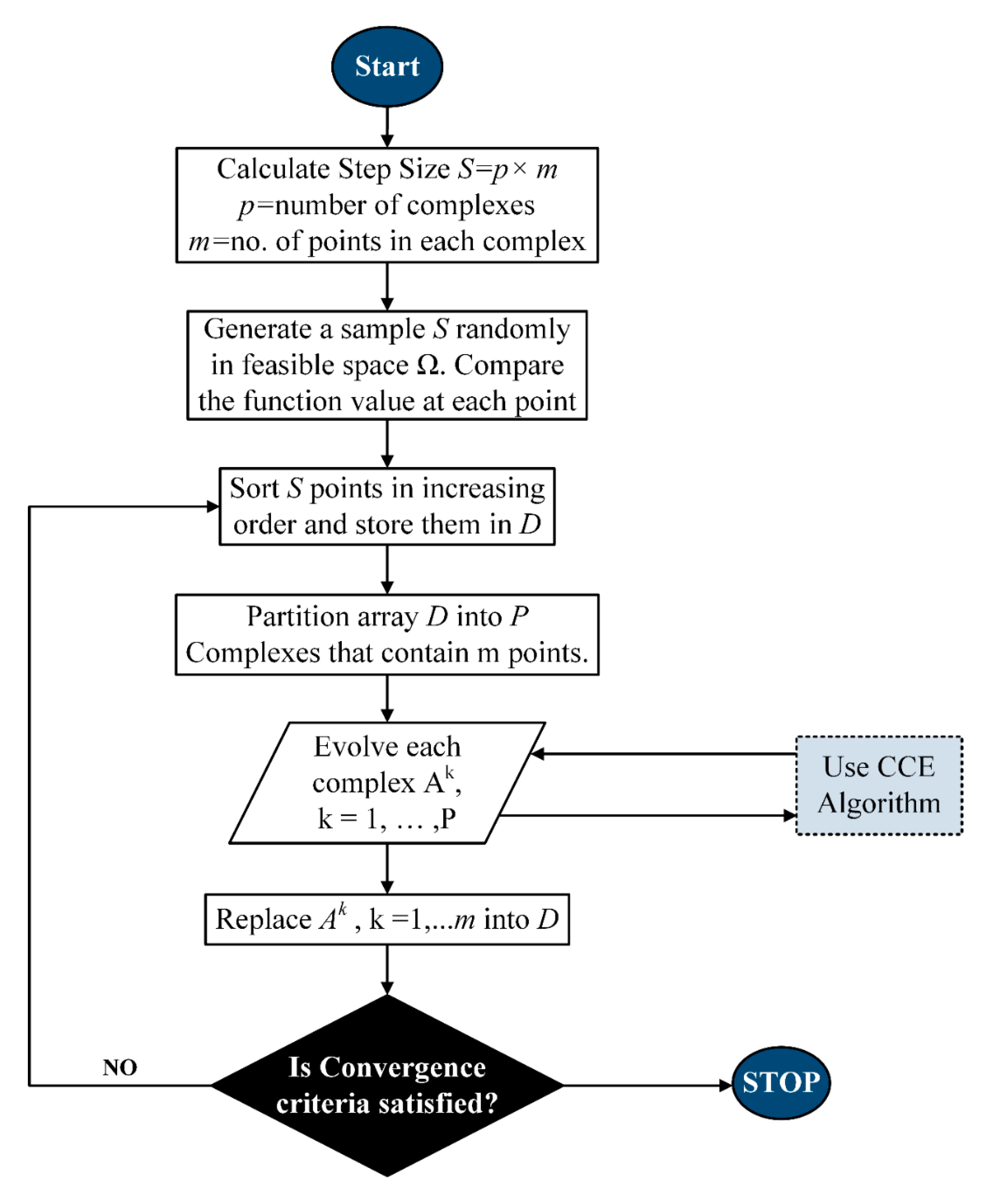
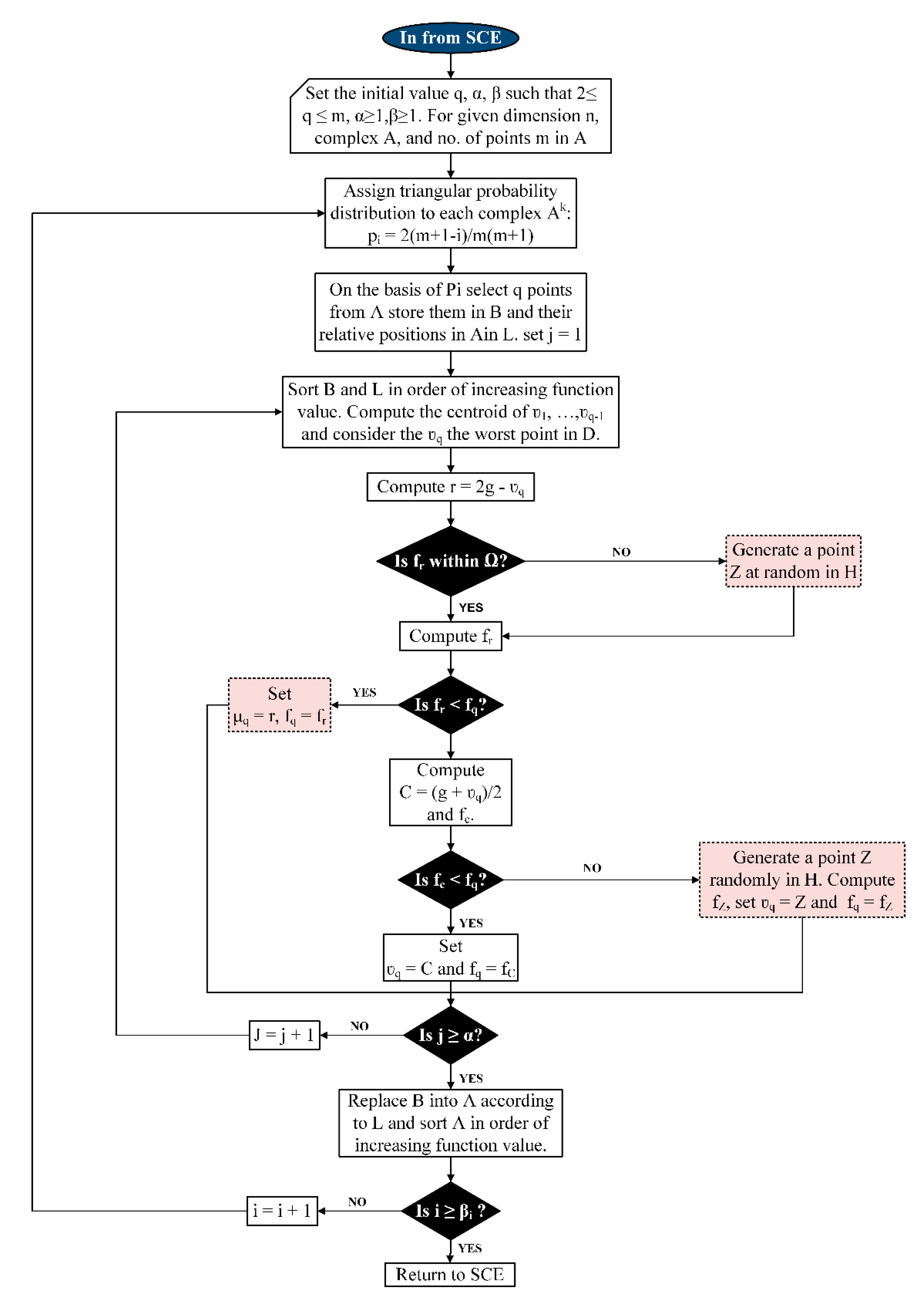
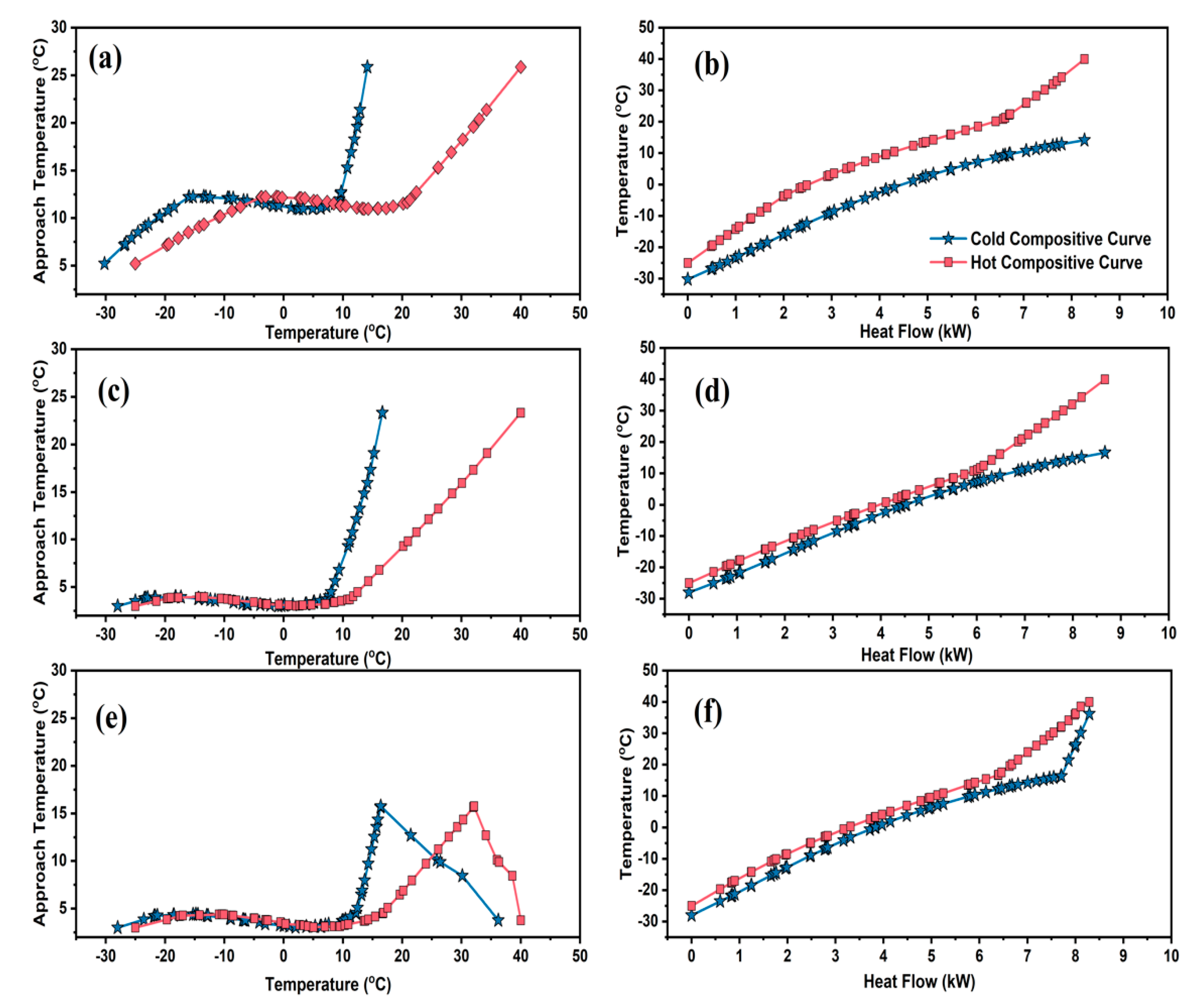
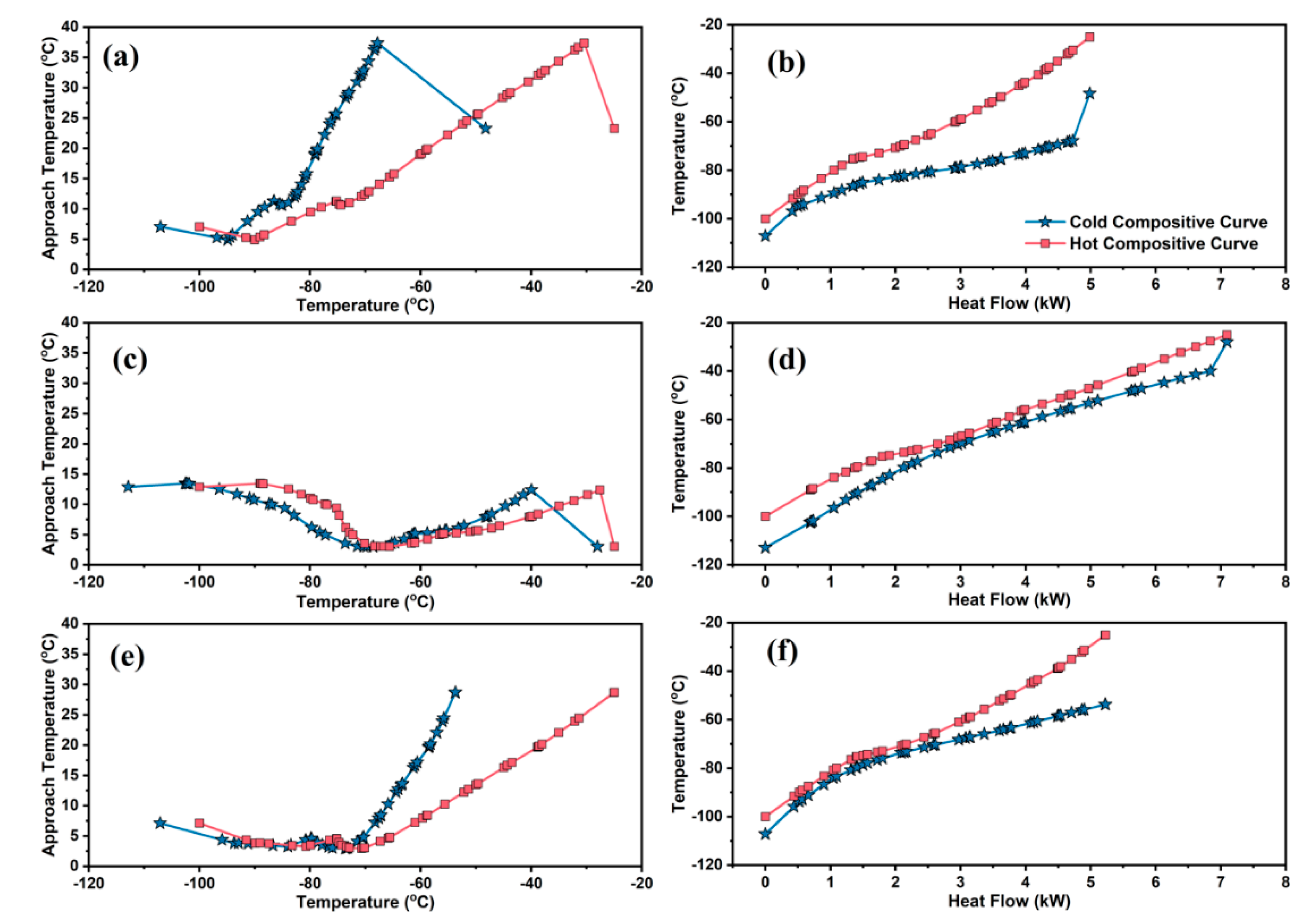
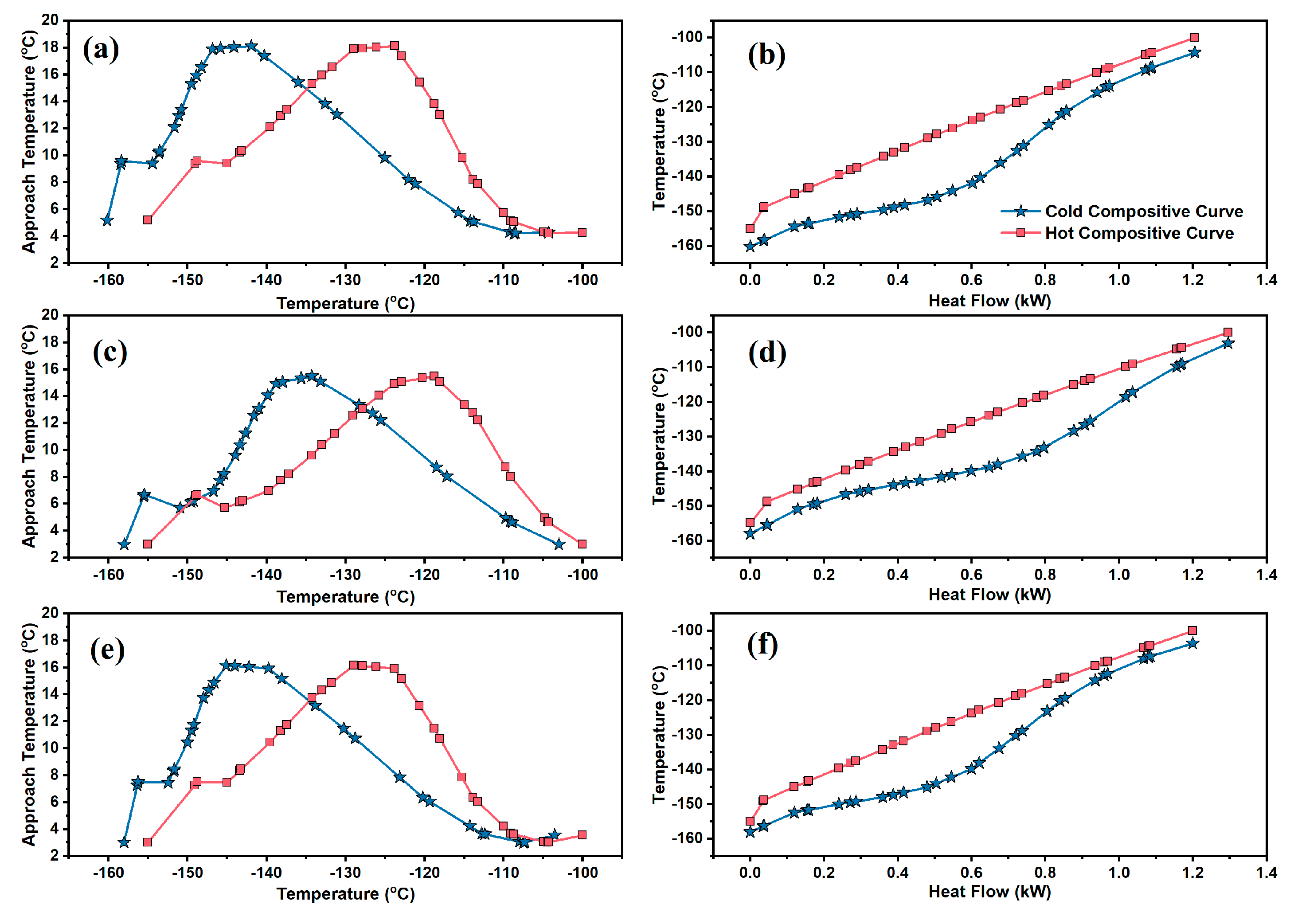
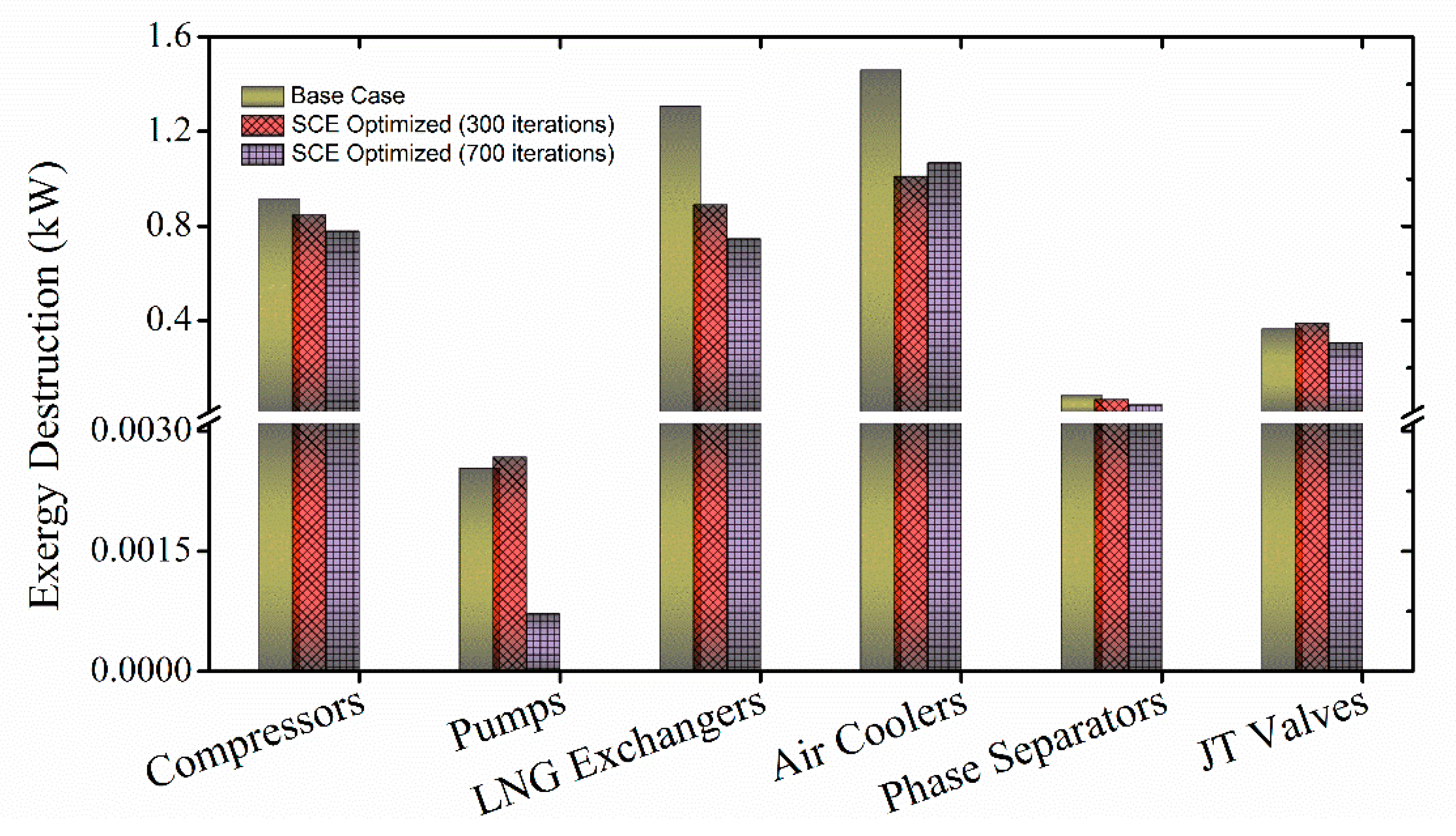
| Property | Value |
|---|---|
| T (°C) | 32 |
| P (bar) | 50 |
| (kmol/hr) | 1.0 (17.82 kg/h) |
| Composition (mol·%) | |
| C1 | 91.35 |
| C2 | 5.36 |
| C3 | 2.14 |
| i-C4 | 0.46 |
| n-C4 | 0.47 |
| i-C5 | 0.01 |
| n-C5 | 0.01 |
| N2 | 0.20 |
| Objective Function: | |||
| Specific energy consumption (kWh/kg-NG) | |||
| Constraint: | |||
| Minimum internal approach temperature (°C) | where, , and X is a vector of the design variables | ||
| Decision Variables | Units | Lower Limit | Upper Limit |
| Precooling cycle | |||
| Evaporation pressure (stream 100-3) | bar | 2 | 8 |
| Condensation pressure (stream 100-8) | bar | 10 | 25 |
| Ethane flow rate, | kg/h | 6.8 | 24.8 |
| Propane flow rate, | kg/h | 9.5 | 28.0 |
| n-butane flow rate, | kg/h | 12.0 | 55.0 |
| Liquefaction cycle | |||
| Evaporation pressure (stream 101-4) | bar | 2 | 8 |
| Condensation pressure (stream 101-9) | bar | 10 | 35 |
| Methane flow rate, | kg/h | 2.2 | 7.5 |
| Ethane flow rate, | kg/h | 10.0 | 35.0 |
| Propane flow rate, | kg/h | 5.5 | 22.0 |
| Sub-cooling cycle | |||
| Evaporation pressure (stream 102-5) | bar | 2 | 8 |
| Condensation pressure (stream 102-1) | bar | 35 | 60 |
| Methane flow rate, | kg/h | 1.623 | 5.5 |
| Ethane flow rate, | kg/h | 1.771 | 7.5 |
| Nitrogen flow rate, | kg/h | 0.85 | 3.5 |
| Decision Variables | Units | Base Case | SCE-Optimized Process | |
|---|---|---|---|---|
| No. of Iterations | ||||
| 300 | 700 | |||
| Precooling cycle | ||||
| Evaporation pressure (stream 100-3) | bar | 3.50 | 4.19 | 3.80 |
| Condensation pressure (stream 100-8) | bar | 25.00 | 21.09 | 19.10 |
| Pressure ratio | 7.14 | 5.03 | 5.03 | |
| Ethane flow rate, | kg/h | 15.00 | 16.69 | 12.51 |
| Propane flow rate, | kg/h | 12.36 | 16.05 | 14.23 |
| n-butane flow rate, | kg/h | 42.00 | 36.75 | 32.89 |
| Precooling MR flow rate | kg/h | 69.36 | 69.49 | 59.63 |
| Liquefaction cycle | ||||
| Evaporation pressure (stream 101-4) | bar | 1.42 | 5.17 | 2.49 |
| Condensation pressure (stream 101-9) | bar | 32.00 | 31.58 | 27.51 |
| Pressure ratio | 22.54 | 6.11 | 11.05 | |
| Methane flow rate, | kg/h | 1.750 | 9.99 | 3.02 |
| Ethane flow rate, | kg/h | 23.90 | 22.40 | 22.87 |
| Propane flow rate, | kg/h | 6.49 | 12.14 | 9.29 |
| Liquefaction MR flow rate | kg/h | 32.14 | 44.53 | 35.18 |
| Subcooling cycle | ||||
| Evaporation pressure (stream 102-5) | bar | 2.00 | 3.58 | 2.02 |
| Condensation pressure (stream 102-9) | bar | 58.00 | 50.50 | 49.90 |
| Pressure ratio | 29.00 | 14.11 | 24.70 | |
| Methane flow rate, | kg/h | 4.57 | 5.56 | 4.48 |
| Ethane flow rate, | kg/h | 2.42 | 2.56 | 2.66 |
| Nitrogen flow rate, | kg/h | 0.75 | 1.39 | 0.50 |
| Subcooling MR flow rate | kg/h | 7.74 | 9.51 | 7.64 |
| MITA(X)LNG-100 | °C | 5.2 | 3.0 | 3.0 |
| MITA(X)LNG-101 | °C | 4.9 | 3.0 | 3.0 |
| MITA(X)LNG-102 | °C | 4.2 | 3.0 | 3.0 |
| LNG liquid fraction | 0.95 | 0.95 | 0.95 | |
| Total compression power | kW | 5.953 | 5.057 | 4.773 |
| Specific compression power | kWh/kg | 0.334 | 0.284 | 0.268 |
| Relative energy saving | % | 14.97 | 19.76 | |
| Elapsed time | Sec | 17,840 | 49,190 | |
| Streams | Base Case | MFC_300 | MFC_700 | |||
|---|---|---|---|---|---|---|
| T (°C) | P (bar) | T (°C) | P (bar) | T (°C) | P (bar) | |
| 100−01 | 40 | 24.4 | 40 | 20.49 | 40 | 18.5 |
| 100−02 | −25 | 23.4 | −25 | 19.49 | −25 | 17.5 |
| 100−03 | −30.22 | 3.5 | −28 | 4.193 | −28 | 3.802 |
| 100−04 | 14.13 | 3.4 | 16.66 | 4.093 | 36.22 | 3.702 |
| 100−05 | 14.13 | 3.4 | 16.66 | 4.093 | 36.22 | 3.702 |
| 100−06 | 14.13 | 3.4 | 16.66 | 4.093 | 36.22 | 3.702 |
| 100−07 | 15.7 | 25 | 17.94 | 21.09 | 37.52 | 19.1 |
| 100−08 | 105.9 | 25 | 93.16 | 21.09 | 110 | 19.1 |
| 100−09 | 40 | 24.7 | 40 | 20.79 | 40 | 18.8 |
| 100−10 | 38.3 | 24.7 | 40.52 | 20.79 | 40 | 18.8 |
| 100−11 | 40 | 24.4 | 40 | 20.49 | 40 | 18.5 |
| 101−01 | 40 | 31.7 | 40 | 31.28 | 35.98 | 27.21 |
| 101−02 | −25 | 30.7 | −25 | 30.28 | −25 | 26.21 |
| 101−03 | −100 | 29.7 | −100 | 29.28 | −100 | 25.21 |
| 101−04 | −107 | 1.42 | −112.9 | 5.167 | −107.1 | 2.492 |
| 101−05 | −48.26 | 1.32 | −28.02 | 5.067 | −53.7 | 2.392 |
| 101−06 | −48.45 | 1.22 | −28.16 | 4.967 | −54.56 | 2.292 |
| 101−07 | −48.45 | 1.22 | −28.16 | 4.967 | −54.56 | 2.292 |
| 101−08 | −46.47 | 32 | −26.15 | 31.58 | −52.88 | 27.51 |
| 101−09 | 138.8 | 32 | 88.83 | 31.58 | 87.32 | 27.51 |
| 101−10 | 40 | 31.7 | 40 | 31.28 | 40 | 27.21 |
| 101−11 | 40 | 31.7 | 40 | 31.28 | 35.98 | 27.21 |
| 102−01 | 40 | 57.7 | 12.48 | 50.2 | 34.12 | 49.6 |
| 102−02 | −25 | 56.7 | −25 | 49.2 | −25 | 48.6 |
| 102−03 | −100 | 55.7 | −100 | 48.2 | −100 | 47.6 |
| 102−04 | −155 | 54.7 | −155 | 47.2 | −155 | 46.6 |
| 101−05 | −160.2 | 2 | −158 | 3.58 | −158 | 2.016 |
| 102−06 | −104.3 | 1.9 | −103 | 3.48 | −103.5 | 1.916 |
| 102−07 | −104.3 | 1.9 | −103 | 3.48 | −103.5 | 1.916 |
| 102−08 | −104.3 | 1.9 | −103 | 3.48 | −103.5 | 1.916 |
| 102−09 | 137.9 | 58 | 86.43 | 50.5 | 123.2 | 49.9 |
| 102−10 | −101.5 | 58 | −100.2 | 50.5 | −100.7 | 49.9 |
| 102−11 | 40 | 57.7 | 40 | 50.2 | 40 | 49.6 |
| 102−12 | 40 | 57.7 | 12.48 | 50.2 | 34.12 | 49.6 |
| NG FEED | 32 | 50 | 32 | 50 | 32 | 50 |
| NG−01 | −25 | 49 | −25 | 49 | −25 | 49 |
| NG−02 | −100 | 48 | −100 | 48 | −100 | 48 |
| NG−03 | −148.8 | 47 | −148.8 | 47 | −148.8 | 47 |
| NG−04 | −158.5 | 1.209 | −158.5 | 1.209 | −158.5 | 1.209 |
| Equipment | Exergy Destruction (kW) |
|---|---|
| Compressor | |
| Pump | |
| Interstage coolers | |
| Phase separator | |
| JT valve | |
| LNG heat exchanger |
| Equipment | Exergy Destruction (kW) | Exergy Destruction (kW) | Exergy Destruction (%) | Exergy Destruction (kW) | Exergy Destruction (%) |
|---|---|---|---|---|---|
| Base Case | SC_300 | SC_700 | |||
| Compressors | |||||
| K−100 | 0.3511 | 0.3193 | −9.05 | 0.2920 | −16.84 |
| K−101 | 0.4165 | 0.3927 | −5.71 | 0.3488 | −16.24 |
| K−102 | 0.1454 | 0.1355 | −6.81 | 0.1364 | −6.19 |
| Net exergy destruction | 0.9130 | 0.8475 | −7.17 | 0.7772 | −14.87 |
| Pumps | |||||
| P−100 | 0.0025 | 0.0010 | − | 0.0000 | − |
| P−101 | 0.0000 | 0.0000 | − | 0.0004 | − |
| P−102 | 0.0000 | 0.0017 | − | 0.0003 | − |
| Net exergy destruction | 0.0025 | 0.0027 | −99.99 | 0.0007 | −100 |
| Cryogenic LNG exchangers | |||||
| LNG−100 | 0.4356 | 0.2620 | −39.87 | 0.2075 | −52.37 |
| LNG−101 | 0.6502 | 0.4378 | −32.68 | 0.3531 | 163.4 |
| LNG−102 | 0.2214 | 0.1905 | −13.97 | 0.1850 | −16.43 |
| Net exergy destruction | 1.3073 | 0.8902 | −31.9 | 0.7456 | 61.03 |
| Air Coolers | |||||
| E−100 | 1.0094 | 0.8109 | −19.66 | 0.8792 | −12.9 |
| E−102 | 0.3620 | 0.1683 | −53.52 | 0.1221 | −66.27 |
| E−103 | 0.0893 | 0.0300 | −66.4 | 0.0667 | −25.26 |
| Net exergy destruction | 1.4607 | 1.0092 | −30.91 | 1.0680 | −26.88 |
| Phase Separators | |||||
| V−100 | 0.0000 | 0.0310 | − | 0.0048 | − |
| V−101 | 0.0557 | 0.0212 | −61.88 | 0.0388 | −30.3 |
| V−102 | 0.0269 | 0.0150 | −44.38 | 0.0000 | −100 |
| Net exergy destruction | 0.0826 | 0.0672 | −18.6 | 0.0436 | −47.18 |
| Joule-Thomson (Flash) Valves | |||||
| JTV−100 | 0.0805 | 0.0605 | −24.8 | 0.0463 | −42.48 |
| JTV−101 | 0.0925 | 0.1404 | 51.73 | 0.0825 | −10.8 |
| JTV−102 | 0.0594 | 0.0559 | −5.93 | 0.0466 | −21.57 |
| JTV−111 | 0.1319 | 0.1319 | 0 | 0.1319 | 0 |
| Net exergy destruction | 0.3644 | 0.3887 | 6.69 | 0.3074 | −15.64 |
| Overall process exergy destruction | 4.1304 | 3.2055 | −22.39 | 2.9425 | −28.76 |
| MFC Process | Actual Work kW | Thermodynamic Efficiency (%) | Relative Improvement in Thermodynamic Efficiency (%) |
|---|---|---|---|
| Base case | 5.953 | 32.8 | – |
| MFC_SCE-300 | 5.057 | 38.7 | 18.0 |
| MFC_SCE-700 | 4.773 | 41.0 | 25.0 |
© 2020 by the authors. Licensee MDPI, Basel, Switzerland. This article is an open access article distributed under the terms and conditions of the Creative Commons Attribution (CC BY) license (http://creativecommons.org/licenses/by/4.0/).
Share and Cite
Majeed, K.; Qyyum, M.A.; Nawaz, A.; Ahmad, A.; Naqvi, M.; He, T.; Lee, M. Shuffled Complex Evolution-Based Performance Enhancement and Analysis of Cascade Liquefaction Process for Large-Scale LNG Production. Energies 2020, 13, 2511. https://doi.org/10.3390/en13102511
Majeed K, Qyyum MA, Nawaz A, Ahmad A, Naqvi M, He T, Lee M. Shuffled Complex Evolution-Based Performance Enhancement and Analysis of Cascade Liquefaction Process for Large-Scale LNG Production. Energies. 2020; 13(10):2511. https://doi.org/10.3390/en13102511
Chicago/Turabian StyleMajeed, Khaliq, Muhammad Abdul Qyyum, Alam Nawaz, Ashfaq Ahmad, Muhammad Naqvi, Tianbiao He, and Moonyong Lee. 2020. "Shuffled Complex Evolution-Based Performance Enhancement and Analysis of Cascade Liquefaction Process for Large-Scale LNG Production" Energies 13, no. 10: 2511. https://doi.org/10.3390/en13102511
APA StyleMajeed, K., Qyyum, M. A., Nawaz, A., Ahmad, A., Naqvi, M., He, T., & Lee, M. (2020). Shuffled Complex Evolution-Based Performance Enhancement and Analysis of Cascade Liquefaction Process for Large-Scale LNG Production. Energies, 13(10), 2511. https://doi.org/10.3390/en13102511









